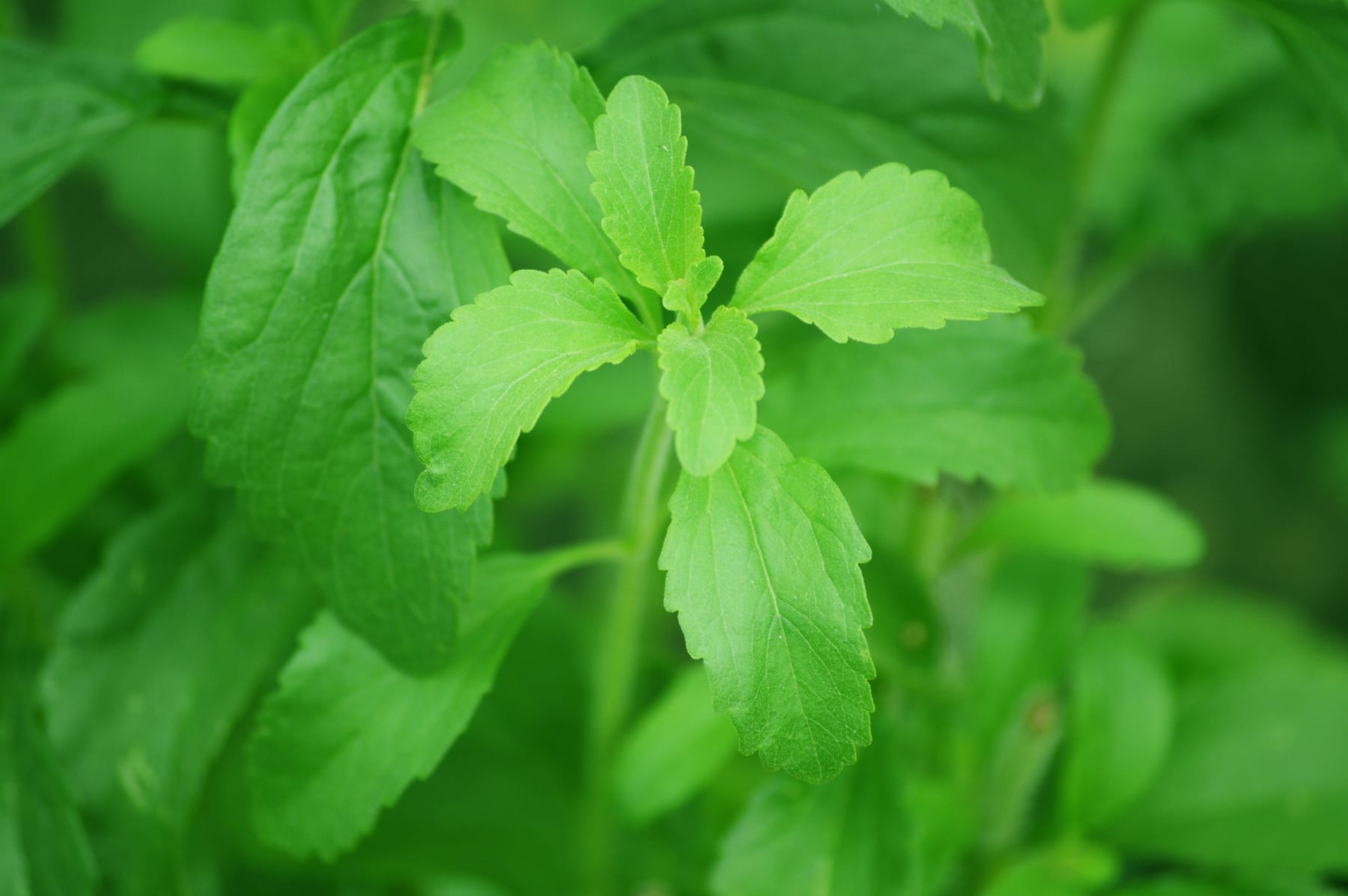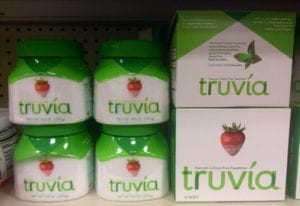Recognizing its harmful effects, more consumers are choosing products without added sugar. The result is a flourishing alternative sweetener market and confusion about which sugar substitutes are harmful or healthy. Stevia has been a leading natural sweetener until several well-meaning bloggers have maligned it as no better than synthetic sweeteners. So, what is the truth? Is stevia harmful or healthy?
What is stevia?

Stevia is a small perennial and subtropical herb native to South America. There are more than 150 species of stevia but the most prized variety is Stevia rebaudiana. Two sweet glycosides were isolated from its leaves by scientists in 1931— stevioside and rebaudioside. Both are sweet but stevioside leaves a stronger bitter aftertaste that some find disagreeable. Other naturally occurring glycosides are rebaudioside B and rebaudioside C.
Sweetness comparison (1)
|
Sweetener |
Potency (X sweeter than sugar) |
Calories (per tsp.) |
| Sucrose |
— |
16 |
| Monk Fruit (Lo Han Guo) |
300 |
0 |
| Stevia (highly processed) |
250 |
0 |
| Stevia (Green leaf) |
40 |
0 |
| Xylitol |
1 |
9.6 |
| Erythritol |
0.7 |
1 |
How stevia is processed
There are three main types of stevia: green leaf stevia, stevia extracts, and highly-processed stevia. Being aware of each type is important for choosing a stevia that is healthy rather than harmful.
- Green leaf stevia — the type that has centuries of safe use behind it — is minimally processed. The leaves are dried and ground into a fine green powder. This type is approximately 30 to 40 times sweeter than sucrose and retains the health benefits of stevia.
- Some stevia extracts further process the green powder with water and alcohol (minimally processed stevia extracts). The resulting extract is then subjected to an enzymatic process to reduce the bitter aftertaste. These are often liquid extracts and contain a variety of glycosides, not just one.
- The worst extracts are highly processed — often undergoing dozens of steps — to create a processed stevia extract that resembles little of what it was in the leaf. These extracts are typically white powders or liquids and concentrated for the sweeter and less bitter part of the leaf (rebaudioside A). Chemical solvents are added to the rebaudioside after it is extracted from the leaf. Then the fillers and other ingredients are added to produce a very sweet and highly treated sweetener. In fact, one commercial stevia product (Truvia) admits on its website that it contains less than 1% stevia. (2) Interestingly, these are the extracts the FDA and other government regulatory agencies have approved for human consumption, but the whole leaf or crude stevia extracts are not.
Concerns over additives
Many bloggers point out that stevia often contains fillers and flavor enhancers like maltodextrin, sugar alcohols, dextrose, cellulose, and other natural flavors. This is true, especially among name-brand stevia products. However, the additive concern can be easily overcome by a savvy label reader. Some manufacturers also share their extraction method/process on their website.
The alleged harmful effects of stevia
Despite its centuries of safe use in Brazil, and Paraguay, and a long history of sage use in Japan several adverse effects have been attributed to stevia consumption. This list includes infertility, hormonal changes, low blood sugar, stressed adrenals, headaches, blood pressure dysregulation, dizziness, thyroid trouble, and even cancer. Let’s explore the evidence to support these allegations.
Infertility and hormonal changes may be a concern if large amounts are consumed. A 1999 study found that administering 6.7g/kg body weight of stevia extract produced functional changes to the male reproductive organs and resulted in lower testosterone levels in rats. (3A,3B) The problem with applying this study to humans is primarily the dose. In 2008, the Joint FAO/WHO Expert Committee on Food Additives established the safe daily intake of steviol glycosides as 4 mg/kg body weight. (3C) This dosage was reaffirmed in 2016. The dose of 6.7g/kg equates to about 469 grams daily in humans. To put this in perspective, you would have to consume over 117 teaspoons of stevia daily to equal this dose. This is an extreme dose that one would hardly be able to consume because of the overwhelming sweetness of stevia.
What about the effects of stevia on blood sugar? This has been tested in both animals and humans. Scientists administered stevia at a dose of 10mg/kg body weight for 28 days in diabetic rats. What the researchers found was that stevia exerted a beneficial effect that increased insulin secretion and reduced blood sugar levels. (4A) This effect appeared to be a result of stevia’s action on the pancreas cells that produce insulin (beta-cells).
Other scientists tested stevia in a food, rather than isolated, which more valid because stevia is typically not consumed alone. This research suggests that consumption of stevia cookies (as opposed to regular cookies) had no significant effect on blood glucose response two hours after consumption. (4B) This same study reported that the stevia cookies reduced hunger — certainly a positive finding for those trying to lose weight. A moringa cookie was also included in the study, which was able to reduce both hunger and blood glucose levels. Similarly, a test in healthy and obsess individuals who consumed tea and crackers with cream cheese sweetened with stevia determined that stevia significantly decreased glucose levels after a meal. (4C) Another clinical study found that stevia enhances glucose tolerance and reduces plasma glucose levels at a dose of 5g of leaf extract every six hours for three days. (4D) Lastly, a single dose of 1,000 mg of stevioside reduced glucose levels after a meal in diabetics. (4E) The current evidence suggests that stevia positively effects blood sugar regulation in healthy and diabetic individuals.
Some experts contend that stevia may stress the adrenal glands. The argument is that the sweet taste of stevia triggers the body to release insulin to shuttle glucose into cells. However, since no glucose exists in the bloodstream, adrenaline and cortisol are released to mobilize sugar stores (glycogen) from other sources (liver, muscles). This argument has some validity and this process might possibly occur. Anecdotal reports from individuals suggest a very small number of people may experience low blood sugar and weakened adrenals after ingesting stevia. But there is little evidence in the form of clinical studies to substantiate this.
The stevia causes cancer fears are a bit of a mystery. Laboratory research suggests that stevioside has an anti-cancer effect in breast, colon, and mouse skin cancer. (5A,5B,5C) Scientists concluded that stevia has no effect on pancreatic cancer development, growth, or death in a mouse model of pancreatic cancer. (5D) One study found that rebaudioside A did not damage DNA or cause genetic mutations in mice when administered at a dose of up to 2g/kg body weight. (5E) A more recent study concluded that stevia and its glycosides do not cause toxicity, cancer, DNA mutations, embryo or fetal harm, and have “therapeutic effects against several diseases such as cancer, diabetes mellitus, hypertension, inflammation, cystic fibrosis, obesity and tooth decay.” (5F) No research to support a carcinogenic effect could be identified. It appears that a connection between stevia and cancer is an exaggeration and not reality.
Current evidence suggests that stevia does influence blood pressure. A two-year, randomized, placebo-controlled study found that taking 500 mg of stevioside powder three times daily significantly reduced both systolic and diastolic blood pressure. (6) No significant incidence of adverse effects was noted between the stevia group and the placebo group. Although four people taking stevia reported gastrointestinal symptoms (abdominal fullness, nausea) and fatigue during the study. Until further clinical research is conducted, it may be prudent for people with low blood pressure to limit stevia.

Steviol is the final product of metabolism and it essentially leaves the body without accumulating. (8) This suggests that stevia and its glycosides are readily metabolized and excreted by the body.
The bottom line
Reasonable use of stevia poses little risk of harmful effects in healthy individuals. People with adrenal fatigue, low blood pressure, low blood sugar, thyroid disorders, or cortisol imbalances may want to limit stevia, especially its long-term use. Your safest bet is to use reasonable amounts of a green leaf extract or minimally processed extracts. Highly processed stevia extracts that don’t contain fillers and additives have a long history of safe use as well but are less preferred. Chances are these are the ones in your favorite products and you have to decide if that product’s benefits outweigh the minimal risks.

